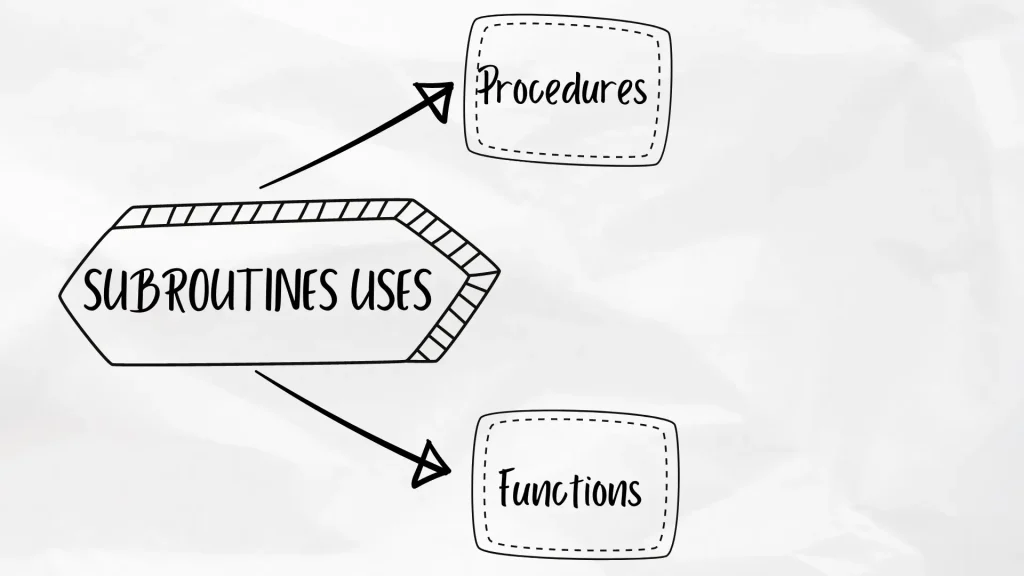Subroutines are instructions that can be called from other parts of your program for better functionality, efficiency, and readability.
Subroutines also help in reducing the length of code written in programming.
These subroutines are programming logic that can be implemented whenever a particular piece of code has to be used multiple times inside programs.
These subroutines can be called from anywhere inside the program.
Subroutines have significant Advantages and Disadvantages of Subroutines | Benefits and Drawbacks of Subroutines are discussed in the following article using examples and images.
The subroutine is one of the most essential concepts in a programming language. Subroutines are small bits of code that perform a specific task, such as printing out text or accepting input from the keyboard.
They can take arguments and return values just like regular functions do.
For a subroutine to work correctly, it needs to be called by another piece of code somewhere else in your program.
This could be within the same function where it was initially defined (see below) or anywhere else within your program’s scope hierarchy (i.e., global variables).
Subroutines are reusable sections of code. They make it easier for you to write programs by reducing the amount of code needed.
What are Subroutines in Programming Language
Subroutines are vital while writing functions in programming languages such as PHP, VB, Python, etc.
Subroutines are programming logic that software developers and programmers develop.
Subroutines are very efficient in reducing programming codes, making them flexible, reusable, and modular in enhancing software applications.

Subroutines are small programming code or logic. That is designed and developed for achieving specific and particular tasks.
The subroutines are very helpful in designing and developing software and applications.
They allow related functions to be grouped into distinct blocks within your application rather than scattered throughout random locations within memory where other parts of the application may not easily access them.
Subroutines are functions or methods that can be called anywhere in your code. They help break up large chunks of logic, making reusing parts of your program more accessible.
Subroutines are also helpful for encapsulation—keeping the data associated with a function hidden inside a separate scope so that it doesn’t get mixed up with other code.
Subroutines are small routines that can be called from anywhere in your code.
They’re used to break up long or complex tasks into smaller, more manageable chunks.
Sub-routines are simply functions or blocks of code that have been assigned names to be called from anywhere else in your program by using the name as an argument in another function call or block.
Subroutines are a way of encapsulating code for reuse in your program.
They are similar to functions in other languages but are typically called from within the same script or process rather than from another script or function.
Subroutines are particularly useful when you want to reuse code but need more space (or time) to create an entire class.
In addition, subroutines can help keep your code organized and readable by breaking it up into smaller pieces with explicit purposes.
Different Purposes of Subroutines
Various purposes of subroutines used in a programming language are mentioned below.
- Subroutines combine similar tasks and operations, making them easier to implement and execute.
- To break extended functions into simple and smaller ones.
- To divide your program into separate modules or classes.
- To make code and functions more readable.
Advantages and Disadvantages of Subroutines | Pros and Cons of Subroutines in Tabular Form
The advantages and disadvantages of subroutines are as follows:
| # | Advantages of Subroutines | Disadvantages of Subroutines |
| 1 | Subroutines make code more efficient and readable. | The main disadvantage of subroutines is scripted will run slower because more calls are being made between them than if they were separate functions. |
| 2 | When the same set of code needs to be written over and over again, in such a case, it makes sense to put the logic in the subroutine. | Debugging is difficult in subroutines, as it has its unique error-handling process. |
| 3 | The code is more readable and easier to maintain; it is considered one of the subroutine’s significant advantages. | The scope for variables defined inside a subroutine cannot be changed once declared outside this block. |
| 4 | Subroutines are a simple way of breaking down complex and large code into smaller pieces that can be reused in different places whenever found necessary. | The main drawback to using subroutines is that they make it much harder for other programmers to understand what your code is written for. |
| 5 | A subroutine lets you combine logic from several places into one place, making it easy to change or fix bugs. | Subroutines that have a single purpose |
| 6 | Other programmers find it easier to update, maintain, and debug subroutines. | If you use a subroutine to allocate memory space when working with arrays or strings, then any part of your program which uses these structures will have no idea how much space each element requires. |
| 7 | Fewer lines of code are written when subroutines are used cleverly. | Subroutines could be faster to operate and execute. It consumes more memory space when completed. |
| 8 | Modularity: Subroutines can break up a program into smaller, more manageable pieces, making it easier to understand and modify. | ————————————– |
| 9 | Abstraction: Subroutines can isolate specific functionality in a program, making it easier to understand how it works and relates to other parts of the program. | —————————————- |
| 10 | Subroutines are one of the most powerful tools in a programmer’s toolbox, but they can also be dangerous if not correctly used and utilized. | ————————————– |
| 11 | Subroutines make the life of a programmer more peaceful because subroutines can be easily implemented. | ————————————- |
Helpful Video: Pros and Cons of Subroutines
Uses of Subroutines in Microprocessor
- Procedures.
- Functions.

What are the 4 Types of Functions or Subroutine in C?
- Functions without arguments and return values.
- Functions without arguments and with return values.
- Functions with arguments and without return values.
- Functions with arguments and with return values.
Recommended Reading
- Characteristics of Object Oriented Programming Languages
- Advantages and Disadvantages of Low Level Language
- Advantages and Disadvantages of Assembly Language
- Why is C++ So Hard to Learn For Beginners
- What are the Importance of C Programming Language
- 10 Advantages and Disadvantages of Machine Language
- What Language is YouTube Written in
- Is Python Written in C
- What is PLC [Programmable Logic Controller]
- Structure of HTML Document With Examples
- Computer Basic Tutorials
Advantages and Disadvantages of Subroutines PDF Download
Get In Touch
I have also written and compiled some articles on computers and telecommunications, and please go through them.
I hope you will like reading it.
All the questions and queries related to 10 Advantages and Disadvantages of Subroutines | Benefits and Drawbacks of Subroutines with examples and images have been answered here.
If you have questions about the Pros and Cons of Subroutines.
Don’t hesitate to contact me, and if you need to add, remove or update anything from the article, please let me know in the comment section or via email.
I will be more than happy to update the article. I am always ready to correct myself.
Please share this article with your friends and colleagues; this motivates me to write more on related topics.
!!! Thank You !!!

Comments are closed.